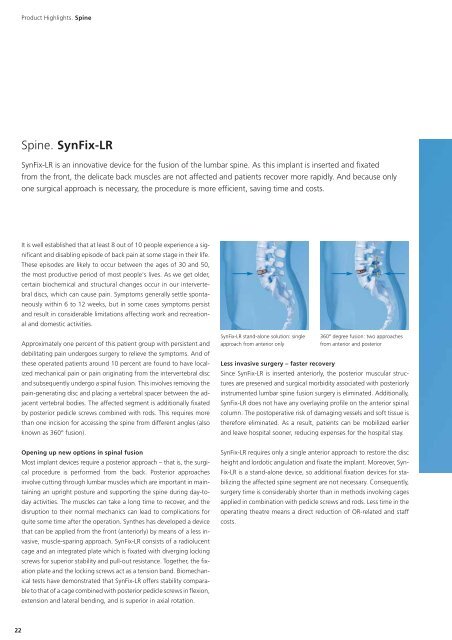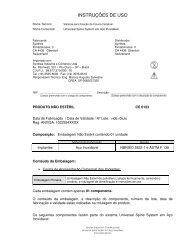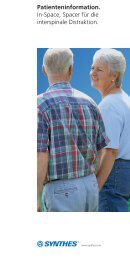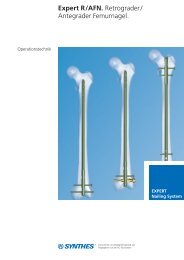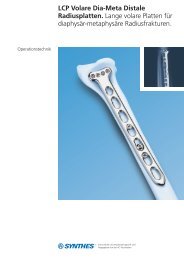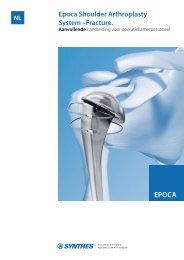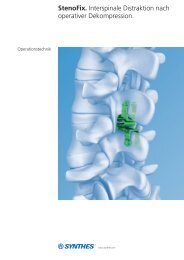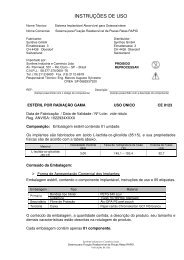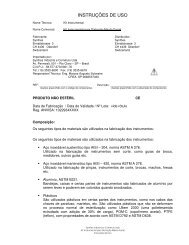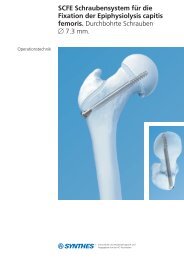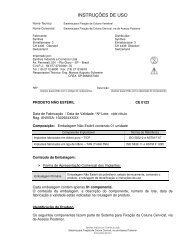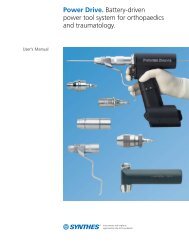Create successful ePaper yourself
Turn your PDF publications into a flip-book with our unique Google optimized e-Paper software.
Product Highlights. Spine<br />
Spine. SynFix-LR<br />
SynFix-LR is an innovative device for the fusion of the lumbar spine. As this implant is inserted and fixated<br />
from the front, the delicate back muscles are not affected and patients recover more rapidly. And because only<br />
one surgical approach is necessary, the procedure is more efficient, saving time and costs.<br />
It is well established that at least 8 out of 10 people experience a significant<br />
and disabling episode of back pain at some stage in their life.<br />
These episodes are likely to occur between the ages of 30 and 50,<br />
the most productive period of most people's lives. As we get older,<br />
certain biochemical and structural changes occur in our intervertebral<br />
discs, which can cause pain. Symptoms generally settle spontaneously<br />
within 6 to 12 weeks, but in some cases symptoms persist<br />
and result in considerable limitations affecting work and recreational<br />
and domestic activities.<br />
Approximately one percent of this patient group with persistent and<br />
debilitating pain undergoes surgery to relieve the symptoms. And of<br />
these operated patients around 10 percent are found to have localized<br />
mechanical pain or pain originating from the intervertebral disc<br />
and subsequently undergo a spinal fusion. This involves removing the<br />
pain-generating disc and placing a vertebral spacer between the adjacent<br />
vertebral bodies. The affected segment is additionally fixated<br />
by posterior pedicle screws combined with rods. This requires more<br />
than one incision for accessing the spine from different angles (also<br />
known as 360° fusion).<br />
SynFix-LR stand-alone solution: single<br />
approach from anterior only<br />
Less invasive surgery – faster recovery<br />
360° degree fusion: two approaches<br />
from anterior and posterior<br />
Since SynFix-LR is inserted anteriorly, the posterior muscular structures<br />
are preserved and surgical morbidity associated with posteriorly<br />
instrumented lumbar spine fusion surgery is eliminated. Additionally,<br />
SynFix-LR does not have any overlaying profile on the anterior spinal<br />
column. The postoperative risk of damaging vessels and soft tissue is<br />
therefore eliminated. As a result, patients can be mobilized earlier<br />
and leave hospital sooner, reducing expenses for the hospital stay.<br />
Opening up new options in spinal fusion<br />
Most implant devices require a posterior approach – that is, the surgical<br />
procedure is performed from the back. Posterior approaches<br />
involve cutting through lumbar muscles which are important in maintaining<br />
an upright posture and supporting the spine during day-today<br />
activities. The muscles can take a long time to recover, and the<br />
disruption to their normal mechanics can lead to complications for<br />
quite some time after the operation. <strong>Synthes</strong> has developed a device<br />
that can be applied from the front (anteriorly) by means of a less invasive,<br />
muscle-sparing approach. SynFix-LR consists of a radiolucent<br />
cage and an integrated plate which is fixated with diverging locking<br />
screws for superior stability and pull-out resistance. Together, the fixation<br />
plate and the locking screws act as a tension band. Biomechanical<br />
tests have demonstrated that SynFix-LR offers stability comparable<br />
to that of a cage combined with posterior pedicle screws in flexion,<br />
extension and lateral bending, and is superior in axial rotation.<br />
SynFix-LR requires only a single anterior approach to restore the disc<br />
height and lordotic angulation and fixate the implant. Moreover, Syn-<br />
Fix-LR is a stand-alone device, so additional fixation devices for stabilizing<br />
the affected spine segment are not necessary. Consequently,<br />
surgery time is considerably shorter than in methods involving cages<br />
applied in combination with pedicle screws and rods. Less time in the<br />
operating theatre means a direct reduction of OR-related and staff<br />
costs.<br />
22


